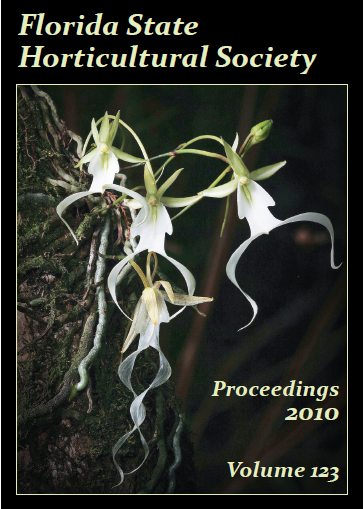Citrus
Evaluation of Candidatus Liberibacter asiaticus Titer in Field-infected Trifoliate Cultivars: Preliminary Evidence for HLB Resistance
Abstract
Huanglongbing (HLB) and Asian citrus psyllid (ACP) are widespread at the Ft. Pierce USDA citrus grove, which is managed primarily as a site for research on HLB control and resistance. The variety collection at this grove includes rootstock cultivars grown as scions and grafted onto Sun Chu Sha, and it has become apparent that many trifoliate hybrids have much weaker symptoms of HLB than the monofoliate rootstock suckers. Therefore Poncirus trifoliata and its hybrids were tested for Candidatus Liberibacter asiaticus (CLas )16S rDNA by qPCR. In Nov. 2009 random quadrant leaf-samples and a diagnostic “most symptomatic leaf” sample were collected from the test tree canopies, along with a random sample and diagnostic sample from rootstock suckers. Data were expressed as abundance of CLas relative to citrus dehydrin. The two P. trifoliata had non-detectable or low CLas abundance, as did two citranges, except that diagnostic samples and rootstock samples from the same citranges had a very high CLas titer. Variability was observed in relative CLas abundance among the 10 citranges tested and all showed high CLas in rootstock suckers. The data suggest that Poncirus and some Poncirus hybrids tolerate and/or suppress CLas even when grafted onto a high-titer source, and encourage further work on identifying and characterizing HLB resistance in Poncirus and its hybrids.References
- Folimonova, S.Y., C.J. Robertson, S.M. Garnsey, S. Gowda, and W.O. Dawson. 2009. Examination of the responses of different genotypes of citrus to Huanglongbing (citrus greening) under different conditions. Phytopath. 99:1346–1354.
- Li, W., J.S. Hartung, and L. Levy. 2006. Quantitative real-time PCR for detection and identification of ‘Candidatus Liberibacter’ species associated with citrus huanglongbing. J. Microbiol. Methods 66:104–115.
- Stover, E. and G. McCollum. 2011. Incidence and severity of huanglongbing and Candidatus Liberibacter asiaticus titer among field-infected citrus cultivars. HortScience (submitted).

